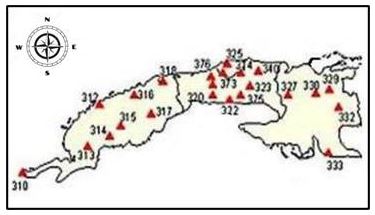Analysis of days with thunderstorms, using thermodynamic indices and derived index
Main Article Content
Abstract
In the research, an analysis of the traditional thermodynamic indices is made, in different synoptic situations typical of the dry and rainy periods in Cuba in the years 2008 and 2019, in which Electrical Storms occurred. The fundamental objective is to determine which one or which of these indices best adjusts to different synoptic configurations, as well as to determine a derived index that improves the prediction of electrical storms in the western region of Cuba. Data from the Global Forecast System (GFS) were used to feed the Weather Research Forecast / Advanced Research (WRF-ARW) mesoscale model, with a spatial resolution of 4 kilometers, covering the western region of Cuba; the chronology of cold fronts and that of electrical storms for the selection of case studies. The correlations determined that the K, TT and GDI indices were the ones that showed the highest correlations, being greater than 0.5. With these results, the derived index was determined, with which a detection of convective processes in the study area of 73 and 75 % was obtained for the dry and rainy periods, respectively.
Downloads
Article Details

This work is licensed under a Creative Commons Attribution-NonCommercial 4.0 International License.
Those authors who have publications with this journal accept the following terms of the License Attribution-NonCommercial 4.0 International (CC BY-NC 4.0):
You are free to:
- Share — copy and redistribute the material in any medium or format
- Adapt — remix, transform, and build upon the material
The licensor cannot revoke these freedoms as long as you follow the license terms.
Under the following terms:
- Attribution — You must give appropriate credit, provide a link to the license, and indicate if changes were made. You may do so in any reasonable manner, but not in any way that suggests the licensor endorses you or your use.
- NonCommercial — You may not use the material for commercial purposes.
- No additional restrictions — You may not apply legal terms or technological measures that legally restrict others from doing anything the license permits.
The journal is not responsible for the opinions and concepts expressed in the works, they are the sole responsibility of the authors. The Editor, with the assistance of the Editorial Committee, reserves the right to suggest or request advisable or necessary modifications. They are accepted to publish original scientific papers, research results of interest that have not been published or sent to another journal for the same purpose.
The mention of trademarks of equipment, instruments or specific materials is for identification purposes, and there is no promotional commitment in relation to them, neither by the authors nor by the publisher.
References
Álvarez L., Borrajero I., Álvarez R., Aenlle L., Rivero I., Iraola C., Rojas Y., Hernández M.,(2012 a) Estudio de la marcha interanual de la frecuencia de ocurrencia de observaciones con tormenta para el territorio cubano. Rev. de Climatología 12 pp1-21, 1578-8768. http://webs.ono.com/reclim/reclim12a.pdf
Bluestein, H. B. (1992).Synoptic-dynamic Meteorology in Midlatitudes: Observations and theory of weather systems (Vol. 2). Taylor & Francis.
Cardenas Posso, Y., Pabon Caicedo, J. D., & Montoya Gaviria, G. D. J. (2004). Statistical thunderstorm short time forecast for the Barranquilla airport.Meteorologia Colombiana, 79-87.
Davison, M., & Gálvez, J. (2016). WPC International Desks. Índices de Estabilidad, 1-104.
Escudero, L. Á., Montejo, I. F., & Morales, R. Á. (2006). Análisis de la tendencia de las series de frecuencia de ocurrencia de observaciones con tormentas, de tormentas con lluvia y de días con tormenta para el territorio Cubano. Revista Cubana de Meteorología, 13(1).
Escudero, L. Á., Montejo, I. B., Morales, R. Á., Ferro, L. A., & Castro, M. B. (2012). Actualización de la distribución espacial de las tormentas eléctricas en Cuba.Revista Cubana de Meteorología,18(1), 83-99.
Escudero, L. Á., & Montejo, I. B. (2016). Caracterización de la marcha anual de fenómenos meteorológicos en Cuba, clasificados según el código de tiempo presente.Revista Cubana de Meteorología,22(1), 3-25.
Figueredo, N. V., & Valdés, E. A. G. Comportamiento De Las Muertes Por Fulguración Ocurridas En Cuba Durante El Periodo 1987-2012.
Galway, J. G. (1956). The lifted index as a predictor of latent instability.Bulletin of the American Meteorological Society,37(10), 528-529.
Gancedo, O. (1981). Horarios de formación de las tormentas en Santa Clara y su distribución.Santa Clara.
Jolliffe, I. T., & Stephenson, D. B. (Eds.). (2012). Forecast verification: a practitioner's guide in atmospheric science. John Wiley & Sons.
Lecha, L., Paz, L., & Lapinel, B. (1994). El clima de Cuba. Editorial Academia, La Habana, 186.
Neumann, C. J. (1971). The thunderstorm forecasting system at the Kennedy Space Center. Journal of Applied Meteorology and Climatology,10(5), 921-936.
Skamarock, W. C., & Klemp, J. B. (2008). A time-split nonhydrostatic atmospheric model for weather research and forecasting applications. Journal of computational physics, 227(7), 3465-3485.
Stern, H. (2002, January). A knowledge-based system to generate internet weather forecasts. In 18th Conference on Interactive Information and Processing Systems.
Tajbakhsh, S., Ghafarian, P., & Sahraian, F. (2012). Instability indices and forecasting thunderstorms: the case of 30 April 2009. Natural Hazards and Earth System Sciences, 12(2), 403-413.

